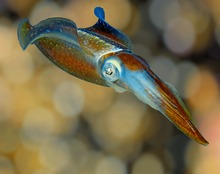Coleoidea
![]()
Cuttlefish is a redirect to this article. For other meanings, see Squid (disambiguation).
![]()
The article needs a revision: it is missing information about the diet.
Please help to improve it, and then remove this marker.
The cuttlefishes (Coleoidea or Dibranchiata) are a subclass of the cephalopods (Cephalopoda) characterized by a shell or its rudiments enclosed by soft tissues and the possession of an ink sac. The best known groups within the squids are the cuttlefishes (Sepiida), the squids (Teuthida) and the octopuses (Octopoda).
Technically, squids are also called coleoids. In some general and popular science texts, they are called cuttlefishes to clarify their affiliation with molluscs. Cuttlefish are not fish (because these belong to the vertebrates).
Colloquially and historically, only cuttlefish are often referred to as "squid". However, the cuttlefishes form only one of four groups within the ten-armed cuttlefishes (Decabrachia). Furthermore, there are eight-armed cuttlefishes (Vampyropoda) with three subgroups. The extinct Belemnites (Belemnoidea) are also counted among the cuttlefishes (Coleoidea), since ink sacs have been found in some complete specimens (see section Systematics).
Currently, about 800 species are known from today's oceans, and new species are still being described all the time. In the fossil record, another 2000 or so species have been identified.
The oldest finds that can be reliably assigned to the squids come from the Lower Carboniferous of North America. Finds of squid from the Lower Devonian of Germany have not yet been confirmed.

Octopus
Features
The internal hard parts and the ink sac distinguish the squids from pearlboats in the broader sense (Nautiloidea) and ammonites (Ammonoidea). These other subclasses of cephalopods have a calcareous exoskeleton and do not possess an ink sac.
Octopuses have a larger ink sac and can therefore use it more frequently in succession than squid. In squid, the ink pouch is sometimes so small that it is only enough to be emptied by the sipho. This already indicates that the primary defensive strategy is not, as commonly supposed, to build up a smoke screen. In reality, the ink secretion forms a relatively small, compact pigment granule cloud that hovers in the place where a moment before the squid shot away by recoil was. The attacking predator is supposed to mistake the ink cloud for the prey animal and lose time with its false attack, which the squid uses to successfully escape. In fact, it can often be observed how predatory fish (e.g. plaice, turbot) snapping into the cloud first cause the wide swirling of the pigments and thus fog themselves. The blue coloration of the ink secretion is due to copper proteins.
All coleoids have two kidneys, one heart and two branchial or gill hearts (atria). Their nervous system shows a high degree of centralization and forms a brain in the back of the head.
In their body size, ability to move and react, squid clearly surpass all other mollusks. Cuttlefish are the most intelligent molluscs. After vertebrates, they have one of the highest forms of organization in the animal kingdom.
RNA editing, which is rare among animals, occurs in squid.

Caribbean reef squid
Systematics
Superorders and orders of the subclass Cuttlefishes (Coleoidea):
- Superorder Belemnites (Belemnoidea) †
- Superorder decapod squid (Decabrachia)
- Order Cuttlefish (Sepiida)
- Order postal squirrels (Spirulida)
- Order Dwarf squids (Sepiolida)
- Order Squid (Teuthida)
- Superorder Eight-armed squid (Vampyropoda)
- Order Vampyromorpha (vampire cuttlefish-like)
- Order Octopus (Octopoda)
- Order Cirrent-bearing octopuses (Cirroctopoda)
The following cladogram illustrates the lineage relationships:
| Squid |
| ||||||||||||||||||||||||||||||||||||
Search within the encyclopedia